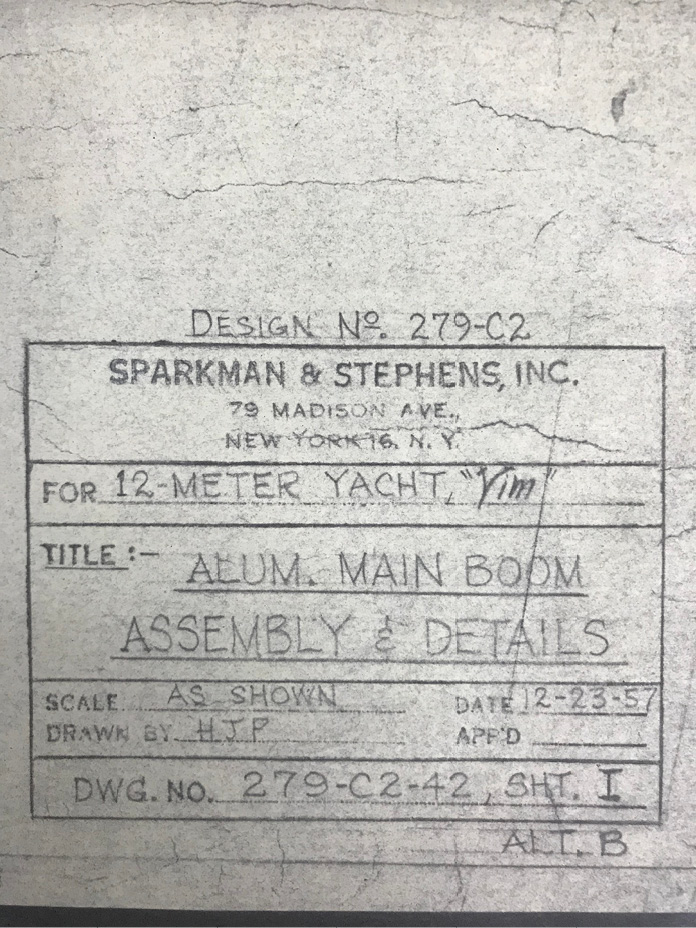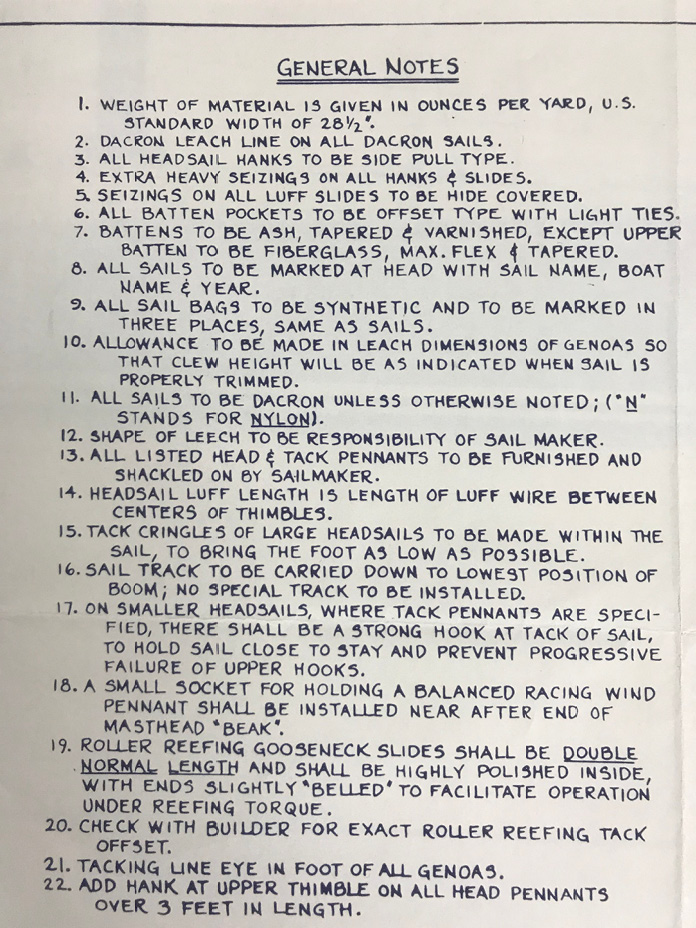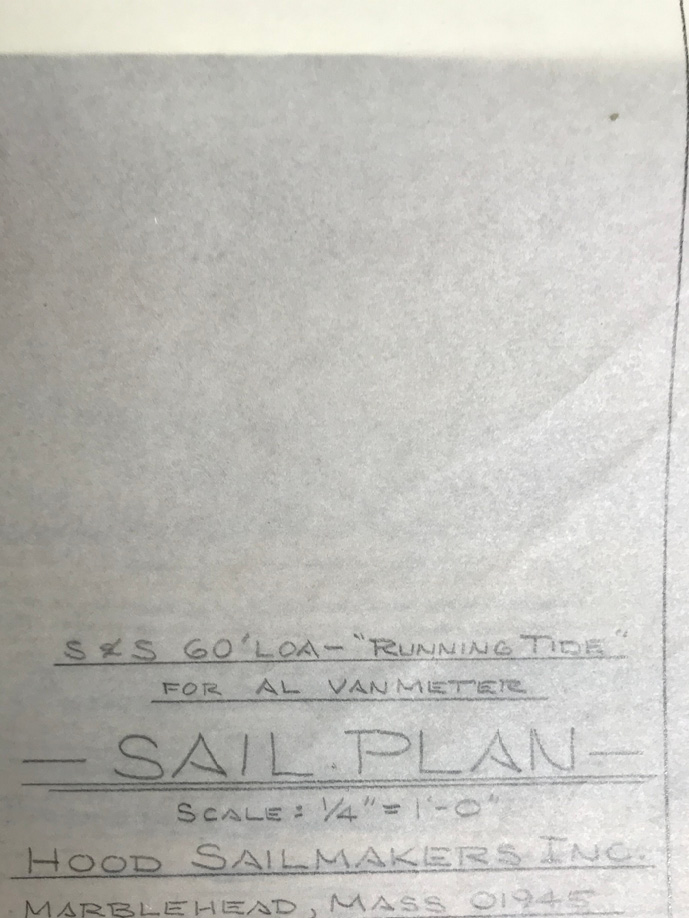By Joe Cooper
Good morning class. This month’s question: Who has seen a sail plan of their boat? OK, there are sail plans of a sort on the brochure on the builder’s website. You can find them elsewhere in the internet. Some of the sporting sailors may well have a trophy incorporating a profile of their boat presented for some successes. But, no, I mean a real live, honest to goodness paper drawing, say a meter square showing the profile of the boat, the spars, the I,J,P,E dimensions, and, at least on plans from back in the day, notes from the designer as to sail details. Sail plans are one of the many critical calculation’s yacht designers construct when drawing a boat. Not surprising when you remember that the sails are the horsepower for your beloved yacht.
The month of June was a true love fest with sail plans for me or any aficionados of sailing, racing, cruising, designers’ famous boats, anything to do with sailing.
Twitter version: I have worked for and with Hood sails for over thirty years. Hood had one of the largest inventories of sail plans in the world I suspect, ten sets of flat file draws with five or six drawers in each file. A few years ago, Quantum purchased Hood. In the spring the decision was made to move buildings, sail lofts, we are now up the road about five miles in Portsmouth, RI. Apart from, moving an entire textile fabrication plant, there were these flat files full of plans. I took on the role of managing the move of the plans.
Holy Cow, what a find. So far, the oldest plan I found is one from Sparkman and Stephens, design #81 dated 1935. It is a blue, Blueprint, of a sweet 30-foot fractional rig daysailer/overnighter, of the type all the major builders are tripping over themselves to reproduce today. Part of the fascination with all these plans is the story they tell, or perhaps offer up to be considered, in the history of, largely American, yachting since, well, before World War Two.
The story of a boat and designer is an interesting one. All designs share a common presentation, based upon the design firm’s “style” – the look of their plans. In his book Sopranino, the late Patrick Ellam records that, on his first visit to the offices of J. Laurent Giles, and his subsequent meeting with Mr. Giles, he, Ellam, thought he looked much more like an artist than a yacht designer. So it is with the best yacht designers, from Herreshoff down to…well, there a number of contemporary designers with an eye for artistry so I will leave you to figure out who they are.
For my money the best artist is Al Mason, the designer behind the Mason line of sailboats. His drawings could easily be framed and hung on the wall as artwork. The signature detail that sticks in my mind is the effort he went to drawing in the buttons on the settee berth cushions. Little circles with the little lines radiating out from the circle like a kid’s picture of a sunrise. This small but seriously evocative detail puts you right inside the boat, at anchor in Maine in September with the heater on, a yummy drink to hand, the fall smells wafting into the cabin.

This drawing, produced in the Sparkman & Stephens office just before Christmas 1957, specifies the assembly and details for the aluminum main boom on the 12-Meter Vim.

S&S also provided “general notes” to be used by sailmakers and riggers.

A corner of Hood Sailmakers’ sail plan for the legendary ocean racer Running Tide, circa 1977.
But for details and instructions to the sailmakers, you cannot beat the plans from Sparkman & Stephens. Most of the plans from this venerable firm have the profile of the boat taking up the bulk of the page.
In, usually the upper left corner, is a table of sails for the boat. It is perfectly common for there to be a dozen sails. There are multiple columns (well before Excel or even Lotus 123) defining the luff, leech and foot lengths, sail areas, sail cloth weight, and often, especially for race boats, the wind speed ranges.
In the upper right section of the plan is a punch list of details concerning each sail.
• Battens to be tied in type
• How long the wire head pennants ought to be
• That each sails name be printed on the sail bag
• The Rake for the main mast.
You can just hear Rod Stephens noting these things down or dictating them perhaps. Actually, it turns out they had an early copy-and-paste system. Many of the lists are in the same hand, so I speculate that they were written out and then transferred to the plan as needed. The hand, for they were all written in longhand printing, is the same across years of designs, from the 1940s to the 1980s.
These file drawers hold plans from every major U.S. yacht designer from the immediate postwar years up to today’s Nelson Marek or Bill Tripp cad. dwgs. with details down to the millimeter. They are very effective, but somehow missing the artistry which is a part of every designer.
But what for the sail plan? Apart from the designer giving us all this information, well really it is only a few who do/did that, sail plans do in fact have an enormous practical application for sailmakers, oddly enough (Oz Humor).
Well, have you ever opened up your new sail on the Friday afternoon of Memorial Day weekend and, bursting with anticipation, rigged your new headsail to find out it does not sheet on the genoa tracks? Not even in the same zip code as the tracks? Well, apart from sail rep’s brain fade or dyslexia (yes, some of us happen to suffer from this, if you can believe it) locating the sheeting position on a sail track involves several bits of information. Without getting into the nuances of the game, these include:
The desired, or required, LP dimension, usually determined in conference with the client in the process of placing the order. Where the tracks start and stop, usually, or ideally, measured on the boat. (Along with confirming the J dimensions, the max hoist, aka 2 Block, length, how high the tack shackle is off the deck if on a furler) the type, make and model of the furler and so the size luff tape that the sail requires. There are about five.
What the mast rake is…is there a backstay adjuster or not? What is the desired clew height, and this is a function of the sail’s intended use. How high the tack is on the furler drum…or not, if a race boat sail. The location on the luff of the sail’s sheeting trim line. Each sailmaker has their rule of thumb for what this is related to the percentage up the luff: 50%, 45%, 55%, all are used depending on the sail. A genoa has one percentage; a blade jib has another. All of these variables, plus a bit of the sales rep’s opinion, experience and eyeball are drafted onto the plan, and a location (a position in 2D space) for the clew is arrived at. Commonly for the average 35-foot cruiser race with a 135 LP roller reefing genoa, this is about three feet off the deck. The luff length is known and so from this clew position the foot and leech lengths are arrived at.
One of the benefits of a sail profile of the boat is it shows the sheer line of the boat. Considering all the nuances needed to arrive at the edge dimensions of a sail, knowing where the sheer is, is a good thing. One can draft up two sails for the “same boat,” – one with the sheer and one without, the latter version rather like a stick figure, and the sheeting locations will be different, sometimes different enough that the sail will not sheet.
Now, all this can be done without a sail plan. There are tricks of the trade, workarounds, that I use, and I am sure all my mates in the game have their own sneakies to arrive at the three edges and the LP length for a headsail. But that is only the headsail.
Perhaps it was not the genoa that did not fit but rather the mainsail which, when fully hosted, laid in top of the bimini. Ah, maybe the boat had more rake than the sail plan suggested? (Again, another great reason for us reps to go and measure the boat.). Slides the right size? Reefs in the right position? If you have reef blocks on the side of the boom, location of the reef points is a critical detail.
Apart from giving us a background portrait upon which to start drafting out the three edges of your sails, the sail plans can in many cases trace the career curve of designers in their early days as they learn their trade. The S&S plans in particular are full of the initials of the later famous designers.
There is a little box in the lower right corner with the particulars of the boat, design number, date, version number, what drawing it is, and “Drafted by.” Here it is we find the pantheon of the world’s future designers. The initials of Dave Pedrick, Roger Marshall, Scott Kaufman, German Frers and many others are to be found in the “Drafted by” fields in the information box. Likewise, in the plans of Ted Hood and the Little Harbor firm, John Alden, McCurdy & Rhodes, Bill Tripp, Senior, and all the rest of the names we know.
Not just the artwork of the drafting, but a chronology of the artists themselves. Fascinating stuff to ponder on. ■
Australian born, Joe ‘Coop’ Cooper stayed in the U.S. after the 1980 America’s Cup where he was the boat captain and sailed as Grinder/Sewer-man on Australia. His whole career has focused on sailing, especially the short-handed aspects of it. He lives in Middletown, RI where he coaches, consults and writes on his blog, joecoopersailing.com, when not paying attention to his wife, dog and several, mainly small, boats.




